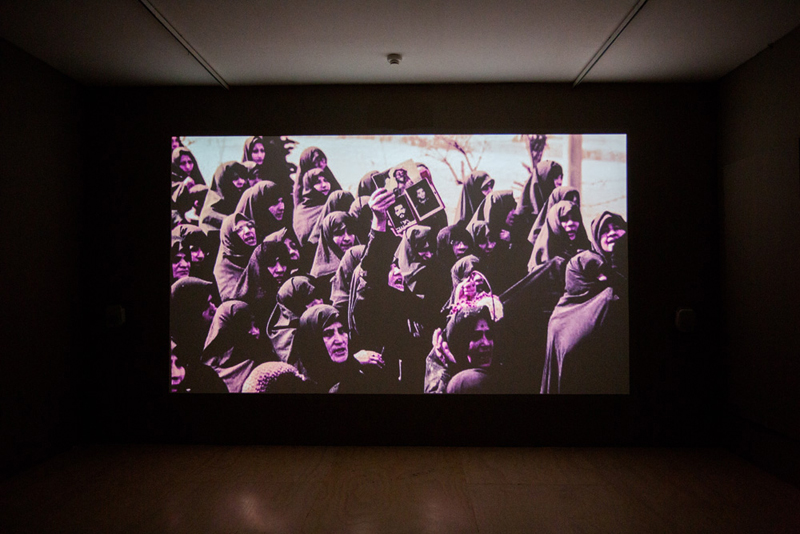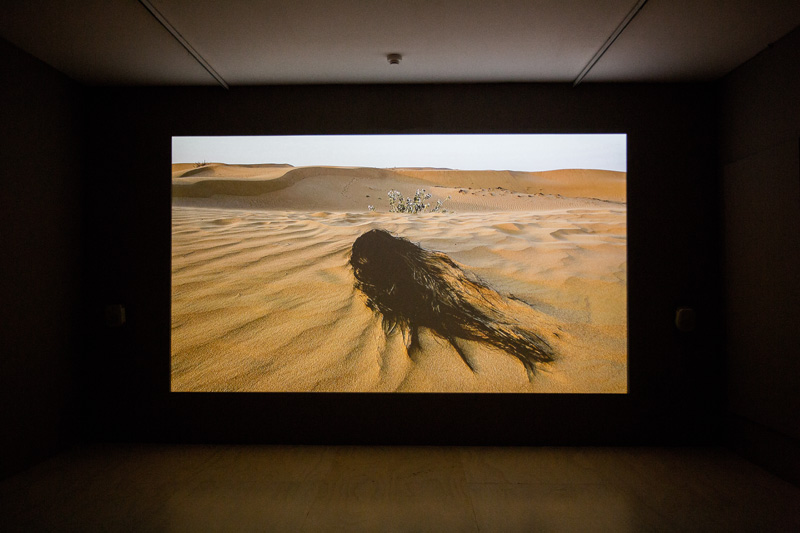IM Heung-soon: “Reincarnation”
The dual-channel projection begins with a female figure looking out to sea. From the first moments of the video, the viewer is aware that the artist has placed the audience between two points of dialogue, and our body is not passive in the space. Viewers shift attention from one wall to the other, keeping up with what seems like a disparate conversation across cultures, but it’s all quite connected. The residue of historical events is examined through place, through the human vestiges that remain pulsing in the air despite being unspoken in public dialogue.
IM Heung-soon’s Reincarnation, 2015, the South Korean artist’s most recent film, is currently on view at PS 1 in Long Island City. At this year’s Venice Biennale, Heung-soon was awarded the Silver Lion for Factory Complex, a work about the oppression of female factory workers. This is the highest award ever received by an individual Korean artist at the Venice Biennial. Effectively editing seemingly incompatible sequences of archival footage with the poetics of art history, Factory Complex and Reincarnation are both focused on female experience, each work presenting historical information not usually discussed in the West.
IM Heung-soon, Reincarnation, 2015. Two-channel HD video; color, sound 23:44 min. Image courtesy of the artist, Sharjah Art Foundation and MoMA PS1. Photo by Pablo Enriquez.
In the early years of the 70s, before the Islamic Revolution of 1979, the rapidly modernizing Tehran was an alluring destination for Korean immigrants seeking economic stability and opportunities. Knowing this history, Heung-soon became interested in a group of Korean women who lived through the Korean war in their youth, the Vietnam war (as entertainers, part of the foxhole circuit), and eventually experienced the Iran-Iraq war of 1980-1988 after settling in Tehran in the 70s. As a viewer seated between three shifting worlds—a woman in a chador wailing in Farsi; a Korean domestic scene; a Vietnamese landscape—it is not obvious how each site is connected historically. Heung-soon focuses on the subtle casualties of war’s aftermath and created a dual-screen installation that places a Western audience between these shifting points of reference that are connected, but unannounced. The viewer experiences confusion, but a steady view into the states of disconnection that contradict normalcy.
IM Heung-soon, Reincarnation, 2015. Two-channel HD video; color, sound 23:44 min. Image courtesy of the artist, Sharjah Art Foundation and MoMA PS1. Photo by Pablo Enriquez.
Those who have not lived through war, or with a veteran, know that violence does not end when wars end. Political conflict may end at national level, but individual survivors of the trauma may continue living and processing their experiences. Heung-soon stages some of these disconcerting moments: a leg shaking while sleeping, a mother praying for her son’s return. The disorienting image of human black hair blowing in the desert wind and sand is a stark reminder of just how buried these histories feel to those who carry them, and how faceless these stories are to most of the world.
“Pain slowly reappears when we try to escape from memory and oblivion. ‘Reincarnation’ does not seek to signify the emergence of an unprecedented phenomenon, but suggests a way of remembering the deceased and the suffering, as well as restoring conscience, morality, empathy, and justice.”—IM Heung-soon
A timelapse of the sea at twilight is particularly beguiling, especially when the camera lingers at the moment where the sky is not yet at its darkest but cerulean steady, and the waves’ foam absorbs an orange hue from distant street lamps. The video thrives on the movement of juxtaposition between screens. In one segment, a sequence of toy soldiers is shown while on the other screen a bonfire is burning in the middle of the woods. When a woman piles $100 dollar bills on a burning offering, the other screen shows Iranian women lighting candles. A strobe of light bouncing off a polished tombstone with arabic script faces a puddle in a tropical setting, reflecting clouds and sky between inverted palm trees. IM Heung-soon’s Reincarnation takes these lesser known histories and presents them in lyrical structures, showing the intense connection between people and place, in the act of coping with the enduring legacies of conflicts without resolution.



